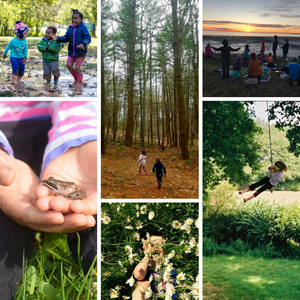Wildschooling
What is Wildschooling?
When my oldest daughter turned pre-school age, my husband and I began having conversations about what we wanted her education to look and feel like. We found that aspects of the local school system and homeschooling models supported some of the things we hold most dear, however, there was no single option available that resonated with the vision we had.
During this time, we went through a lot of soul-searching, research and conversations with each other and our community. Ultimately our family decided to name and create our own version of homeschooling that nourishes the mind, body and spirit: Wildschooling.

What does it include?
More than a curriculum or framework, Wildschooling is a movement designed to honor and support our innate, inexorable bond with nature and lend a voice to our inner wild. Wildschooling continues to take inspiration from a wide-range of sources (to name a few): Forest School, The Reggio Emilia Approach, Earth Schooling, Waldorf, Charlotte Mason, Self-Reg, place-based education, permaculture, peaceful parenting, unschooling, 8 Shields Model, indigenous knowledge and traditions, and most importantly time spent communing with Mother Nature herself.
Who is it for?
Now more than ever, children and nature need each other. Wildschooling was primarily created with home educators in mind. However, this movement is inclusive and can be easily be acknowledged by and integrated into a wide range of families, programs and lifestyles.
Wildschooling is now represented by over 65,000 inspiring, diverse families across the world – each making the movement what it now is.
Wildschooling...
1. Recognizes nature connection as a fundamental human need, right and state of being
We are hard-wired to evolve with nature. We are nature! Nature connection is a developmental and emotional need for children, keying up biological functions that would otherwise be latent. Wildschooling recognizes and champions the need for ALL children to safely access and reconnect to their wild.
2. Values and respects the whole child
Wildschooling values and trusts the child’s need for self-expression, right to move, unfurl and process at their own pace. It honors the thousand languages of the child and supports the child’s fundamental need to grow and develop through risk, play, experimentation, conversation, visceral sensory stimuli and real, tangible life experiences. Relationships and context root Wildschooling and trust in the child gives it wings to fly.
3. Is relationship led
Time in nature isn’t a curriculum extension, backdrop for activities or afterthought. The nature – child connection is a living, breathing relationship – one that has innate value and meaning in and of itself. This life-long dynamic, visceral dance between the wild and the child is the beating heart of Wildschooling.
4. Favors place-bonded, contextual learning
Children must be given the time, space and opportunity to bond with nature. The simplest, most meaningful and effective place to do that is in their nearby nature! By connecting to their local habitat, biome, backyard nature and community, children are participating in a timeless human tradition.
5. Aligns with nature’s rhythms
Wildschooling keeps time with the slower, more intentional rhythms of nature. Instead of the clock, it invites the child to orient to phenological events, circadian rhythms and seasonal shifts (for our family, the lunar cycles play a pivotal role in guiding our lunar year). Tethering to nature’s calendar allows us to recognize the non-linear, more cyclical nature of a child’s development.
6. Favors emergent learning
Because the nature/child relationship is ever-changing and unique to each child, Wildschooling doesn’t lend itself to a traditional curriculum. Often children will display an interest, passion, inquiry or need and the mentor will then draw from resources, projects or other experiences to support and scaffold that spark.
7. Encourages village building
Wildschooling is not exclusive or social isolating. Ideally children are playing and learning in mixed-age, diverse groups. Parents and trusted caretakers are not separated from the child’s learning and life journey. Community events, volunteer projects, outreach and local celebrations help the child to extend their sphere of concern, empathy and passion.
8. Respects and honors ancestral knowledge
The art of survival inspired and strengthened our ancestor’s connection to their environment. Practicing primitive, traditional, and creative arts, helps children foster creativity, identity and a sense of their role within the family, community and wilder world.
9. Preserves and honors story
Sharing and receiving each other’s stories is almost synonymous with being human. Consistently gathering around the fire (metaphorical or real) to partake in that ancient ritual is worth preserving. And when a Wildschooler walks away from the fire, others will be there to receive and integrate that story when that child returns.
10. Supports a future paradigm
Wildschoolers are dandelions bursting through the pavement. This type of approach to life and education aspires to help raise children who are flexible, creative, resilient and empathetic. Although so many of Wildschooling’s tenants draw on the past, I believe this approach can walk our children into their best future.
Wildschooling is not…
A rejection of literacy, writing, math, technology or other fundamental skills
Just bringing traditional school outside
Exclusive or just for those who are homeschooling
Letting kids just run “feral” in the woods (we get this a lot)
Incompatible with modern life
Socially isolating
Just as nature breathes, grows, and enriches itself, so too will this movement. It’s truly an evolving co-creation between nature and the community of those living it every day.
If this resonates with you, please come walk with us on this journey!
Yours, Nicolette
